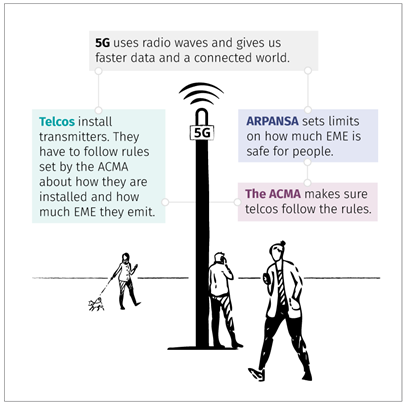EME
Mobile phone networks and wireless devices like remote controls, smart TVs, wi-fi routers and laptops use low-level radio waves to send and receive information. Radiofrequency (RF) electromagnetic energy, known as EME, is a product of these radio signals.
The Australian Radiation Protection and Nuclear Safety Agency (ARPANSA) sets limits for exposure to EME. These limits are based on extensive scientific analysis and are designed to protect people, so they are set well below levels that are known to cause harm.
It’s the ACMA’s role to regulate communications equipment and devices that emit EME. This way we can make sure emissions meet ARPANSA safety standards.

The rollout of 5G
5G is the latest generation of mobile technology. As well as making our smartphones better, 5G allows us to connect almost everyone and everything together, including machines, objects, and devices—everything from smart cities and smart homes, to driverless cars and virtual reality.
The new 5G network currently uses similar radio waves to the 4G network, but in the future will use radio waves at a higher frequency. This will not mean they cause higher levels of exposure to EME.
Higher frequency radio waves are already used in security screening units at airports, police radar guns, remote sensors and in medical devices. These have been tested and found to have no negative impact on human health.
5G is more efficient than previous technologies. The emission levels of 5G equipment are well under the ARPANSA limits.
Small cells
Small cells are low-powered base stations for mobile phones and broadband services. They will play an important role in providing 5G mobile services. Telcos often install small cells on ‘smart’ light pole systems that combine lighting, wi-fi and mobile coverage. Small cells also feature on bus stops, railway stations and advertising panels.
Small cells have a lower power output than older base stations. They can also go into ‘sleep mode’ when not in use. This means their power output and EME emissions will often be lower than 4G base stations.
Telcos install and maintain small cells. In many cases, they do not need local council or other government approval. However, they do need to:
- comply with the Mobile Phone Base Station Deployment Code
- notify local councils, owners and occupiers about planned installations in community locations
- consider any submissions received about a planned installation.
If telcos don’t follow the rules set out in the code, we can direct them to take remedial action and if they fail to do so, we can take action resulting in penalties of up to $250,000 for each contravention.
Read our small cells fact sheet.
Our role
We make sure people, equipment and devices comply with safe EME limits, consistent with the limits set by ARPANSA, the Australian Government’s expert agency on health matters related to EME.
We ensure that certain devices like mobile phones, modems and remote controls have safe EME levels.
We also set rules to make sure that transmitters are safe. This includes mobile phone towers, broadcast towers and small cells. We check:
- their EME levels are below the maximum public exposure levels in ARPANSA’s Radiation Protection Standard
- that telcos are keeping accurate records once a site is in operation.
Through our site inspections and audits, we have found that network facilities like mobile phone base stations have EME emissions substantially below the safe EME levels set by ARPANSA. Our auditing shows that telcos take seriously their responsibility to keep the transmitters within safe EME levels.
Read about our rules for EME. You can complain to us about a mobile phone base station if you think a telco has not followed the Deployment Code.
Misinformation about 5G
Recently, there has been a lot of misinformation online about the health effects of 5G radio towers.
Decades of global scientific research shows the EME exposure from mobile phones and mobile base stations is harmless at low power levels. There is no evidence that radio waves in wireless networks are harmful to our health.
Likewise, there is no link between 5G and COVID-19. Australia's Chief Medical Officer has stated:
'5G does not cause COVID-19. It does not spread COVID-19. Nor does it increase the severity of COVID-19 or make people more susceptible to COVID-19.
The scientific evidence shows that wireless telecommunications, including 5G, do not weaken people’s immune systems and do not place us at higher risk of getting viruses such as COVID-19.'
Learn how to spot misinformation and deal with it.
Find out more
ARPANSA
ARPANSA is an independent government agency tasked with protecting people and the environment from the harmful effects of radiation. They work independently from other parts of government and are not funded by industry.
ARPANSA has information about 5G and your health, as well as how to avoid misinformation about 5G and misinformation linking 5G with COVID-19.
Department of Infrastructure, Transport, Regional Development, Communications and the Arts (DITRDCA)
DITRDCA provides information about EME, based on advice from the Department of Health, ARPANSA and the latest relevant research.
Watch their video for more about EME.
WHO
The World Health Organisation (WHO) has stated there is no established scientific evidence of adverse health effects from very low RF EME exposure. Read its list of myth busters.
The Radio Frequency National Site Archive (RFNSA)
The RFNSA website allows you to:
- search for towers, base stations and small cells near you
- find electromagnetic energy reports
- find community consultation information
- access contact details for the provider.
Your telco
Most large telcos have information about 5G and EME:
International Commission on Non-Ionizing Radiation Protection (ICNIRP)
The ICNIRP is an independent non-profit organisation that provides scientific advice and guidance on the effects of EME.
